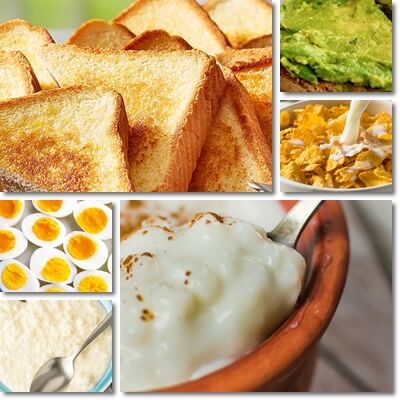Do you have acid reflux disease? Are you looking to get on a diet for acid reflux and need detailed meal plan ideas to help you get started? When you have acid reflux disease, it may seem like everything you eat triggers your symptoms.
As difficult as it may seem to keep it under control, acid reflux disease can be easily managed with diet alone, and responds extremely well to dietary changes, with benefits being visible in as little as one week.
But what do you eat for acid reflux? What foods are good for acid reflux specifically and what foods trigger symptoms such as stomach pain, excessive burping, heartburn, sore throat, regurgitation of stomach juices and a bad, sour or metallic taste in the mouth? Find out what foods to eat and to avoid for acid reflux, and read my personal acid reflux diet plan with 6 recipes for breakfast to help neutralize excess stomach acid and counteract acid reflux symptoms.

What can I eat for breakfast if I have acid reflux? (A List Of 6 Recipes)
1) Oatmeal or oat porridge
Made from 40 grams of thin rolled oats boiled for 5 minutes on low heat in 160 to 200 milliliters of either water or milk, dairy milk or non-dairy nut or cereal milk. Can be eaten as such, or you can add 5 grams of brown sugar as soon as you remove it from the heat, and mix in well.
If you are not allergic, you can also sweeten your oatmeal with one tablespoon of raw honey of your choice. You can choose a mild tasting honey such as acacia honey, or a stronger tasting honey like buckwheat honey, or therapeutic honeys such as manuka honey or the more particular tualang honey to help with acid reflux.
If your acid reflux is not very bad, you can lightly top your oatmeal with raw, unsalted, unsweetened nuts or seeds, or dried or cooked fruit. Options to consider for acid reflux: up to 5 walnuts, almonds or cashews, chopped, a couple of dried apricots, 5-6 unsweetened, un-oiled banana chips.
You may even try 1 small cooked apple (100-150 grams), without skin – just peel, chop and stew the apple in a pan with water and a packet of 5 grams of brown sugar, then use as topping for your oatmeal. However, apples contain organic acids such as malic acid which can trigger acid reflux even when cooked – the more sour and acidic the variety, the more likely it is it will trigger acid reflux.

2) Soft boiled eggs and toast
If you have acid reflux, a good breakfast can consists of 2 soft boiled chicken eggs eaten with 2 slices of toast. The eggs are nutritionally dense, and you can eat both the egg white and egg yolk even if you have acid reflux.
The choice of cooking method makes the eggs easy on the stomach, and not to mention the fact that chicken eggs are lower in fat than duck eggs and other varieties.
Toast is absorbent and bland and not only does not trigger acid reflux symptoms, but it also helps neutralize the side effects of excess stomach acid.
3) Egg white omelet with bread
You can eat whole eggs, both egg white and egg yolk, for breakfast even if you have acid reflux. But you can also just eat the egg whites. Indeed, egg whites are lighter and even easier on the stomach because they are almost fat free, not to mention high-protein, and don’t cause acid reflux.
Use 3-4 egg whites from medium sized chicken eggs, or up to 100 milliliters of egg white, and have 2 to 3 slices of bread, fresh or toasted. Season plainly with salt, and use the least amount of oil to cook the omelet.
Alternatively, you can add other leafy green vegetables such as chicory, arugula, patience dock, sorrel or kale, but only very small amounts. For really bad acid reflux, only eat the egg white omelet with bread which is absorbent and should help neutralize excess stomach acid.
Another option for really bad acid reflux is to whip the egg whites with a pinch of salt and bake them on a piece of parchment paper, without adding any fat whatsoever.
4) Avocado toast
This is a touch and go recipe for acid reflux meaning it will work for some people, but not for others. While healthy, avocado is not for everyone, especially not for everyone with acid reflux. In fact, avocado can be bad for you even if you don’t have acid reflux.
This being said, if you do try this recipe of breakfast, make sure your avocado is well ripened to minimize the risks of side effects. Just scoop your avocado pulp in a small bowl, season plainly with salt, or not, and mash with a fork. Spread on a few slices of toast and your breakfast is ready.
Avocado toast is a light meal, easy on the stomach unless you have issues with avocado specifically, gets digested easily and provides good nutrition in the form of healthy fats and carbs for quick energy, as well as plenty of vitamins and minerals.
Avocado is a great source of potassium with benefits for high blood pressure, and has magnesium which is good for both high blood pressure and arrhythmia, and helps with muscle cramps and muscle soreness.
How much you eat is important when it comes to acid reflux, just as important as what you eat and what you don’t eat (read my 7 diet tips for acid reflux).
With this in mind, I’ve found a good amount of avocado to have for breakfast is 90-100 grams. As for toast, 80-100 grams of toast which can mean 2-3 slices is also an okay amount.
5) Plain cornflakes with milk
Cornflakes are basically toasted flakes of corn and they make a good breakfast option for acid reflux. Choose unsweetened corn flakes and enjoy with up to 250-300 milliliters of milk such as low fat 1.5% cow milk or non-fat 0.1% cow milk, or non-dairy milks such as nut milks or cereal milks.
The (dairy) milk hydrates and provides wonderful nutrition, notably good amounts of potassium, magnesium, vitamin B12, vitamin B2 and vitamins D and A, as well as some fat, being a great slow release energy food.
The corn flakes are good for acid reflux because they are absorbent, helping neutralize excess stomach acid, and provide fiber for good transit and carbs for quick energy.
While you can sweeten your corn flakes breakfast, it’s actually better if you don’t. If you must, choose brown sugar and raw honey over other options – remember to add the raw honey only to cold or warm milk.
6) Sweet rice pudding
For this recipe you can use any type of white rice you like, and either dairy milk or non-dairy milk. You can choose between whole cow milk which is typically 3.5% to 4.2% fat, low-fat 1.5% milk or non-fat 0.1% milk. Or use a non-dairy milk such as nut milk or grain milk.
In a small non-stich pot, add 40 grams of white rice and 120-160 milliliters of water and boil over low to medium low heat while stirring continuously. Stirring helps make the rice pudding sticky. Once the water is absorbed, either the rice is fully cooked, or still needs cooking.
At this point you can add some vanilla bean or vanilla extract and the milk – add 120 milliliters of your choice of milk and proceed to cook while stirring until the rice is cooked and all or most of the milk is absorbed. If the rice is not cooked, add milk and continue until it is – the grains should be cooked, but retain their shape. If the rice is cooked, but everything is a little too watery, don’t worry.
Remove from the heat and add 5 to 10 grams of brown sugar and stir it in so it dissolves. Transfer everything into a bowl or deep plate and allow to cool. The rice will absorb any remaining liquid and form a creamy pudding.
You can prepare the rice pudding in advance, in the evening, and chill in the fridge until morning. You can eat it as it is, or top with a few chopped nuts or seeds, raw, unsalted and unoiled. Alternatively, you can add 2-3 chopped dates or a drizzle of raw honey for added therapeutic effects.
